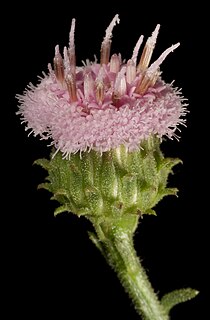
Adenanthos detmoldii, commonly known as Scott River jugflower or yellow jugflower, is a species of shrub in the family Proteaceae. It is endemic to the south-west of Western Australia.

Adenanthos barbiger, the hairy jugflower or hairy glandflower, is a species of shrub in the family Proteaceae. It is endemic to the south-west of Western Australia. It usually grows to 1 metre high, and has bright red flowers that appear mostly between August and December. The species was first formally described in 1839 by English botanist John Lindley in A sketch of the vegetation of the Swan River colony.

Lysiphyllum cunninghamii is a species of plant in the family Fabaceae. It is native to northern Australia where it occurs from Western Australia through the Northern Territory to Queensland.

Hardenbergia comptoniana is a species of flowering plant in the pea family, Fabaceae, native to Western Australia. A twining vine, it produces purple flowers in the Southern Hemisphere spring. It is found on sand dunes and sand plains, and in open forest, on sand- or clay-based soils. It is readily cultivated in the garden, where it does best in a part-shaded position.

Parsonsia diaphanophleba is a woody vine of the family Apocynaceae. It is found in Western Australia and is listed as a priority 4 species.

Amyema bifurcata is an epiphytic, flowering, hemiparasitic plant of the family Loranthaceae native to Australia and found in Western Australia, the Northern Territory, Queensland and New South Wales.

Amyema gibberula is an aerial hemiparasitic plant of the family Loranthaceae native to Australia and found in Western Australia, the Northern Territory, and South Australia.

Dicrastylis exsuccosa is a species of plant within the genus, Dicrastylis, in the family Lamiaceae. It is endemic to inland Australia and found in Western Australia, the Northern Territory and South Australia.

Maireana pyramidata is a species of plant within the genus, Maireana, in the family Amaranthaceae. It is endemic to Australia, and widespread throughout Australia in the inland, where it is found in Victoria, New South Wales, Queensland, the Northern Territory and Western Australia.

Boronia lanuginosa is a plant in the citrus family Rutaceae and is endemic to northern Australia. It is a shrub with woolly pinnate leaves.

Daviesia divaricata, common-name Marno, is a shrub in the family Fabaceae. It is endemic to Western Australia. It usually grows from 0.3–3 metres (1–10 ft) high. Bentham describes it as having no leaves, and having smooth, green, rigid stems which are circular in cross-section (terete), having grooved spines at their tips. Stems branch off from one another at a wide-angle, giving the species its name, divaricatus being the Latin for wide-spreading. Its orange pea flowers, with their yellow, brown, red and purple centres, are produced between June and November in the species' native range. It grows on sand, over both limestone and laterite, and is found on sandplains, rocky outcrops, and roadsides.

Scaevola canescens is a species of plant in the family Goodeniaceae. It is endemic to Western Australia where it occurs "from Shark Bay to Perth, in open forest and heath in sandy soil".

Opercularia vaginata (dogweed) is a species of plant within the genus Opercularia, in the family Rubiaceae. It is endemic to the southwest of Western Australia.

Bossiaea eriocarpa, or the common brown pea, is a species of flowering plant in the pea family, Fabaceae. It is native to Western Australia, and found in Beard's south-west province.

Velleia macrophylla, or large-leaved Velleia, is a perennial herb in the family Goodeniaceae, which is endemic to Western Australia. It grows on moist sites in Beard's South-west province. It flowers from October to December or January.

Podotheca chrysantha is a small herb in the family Asteraceae endemic to Western Australia. It grows from 0.2 to 0.5 m high, and has yellow flowers which are seen from August to December. It grows in sand over limestone or laterite on limestone ridges and in wet depressions.

Acacia simsii is a shrub belonging to the genus Acacia in the family Fabaceae. It is native to New Guinea and northern Australia. In Australia it is found in both the Northern Territory and Queensland.

Wurmbea tenella, common name - eight nancy, is a perennial herb in the Colchicaceae family that is native to Western Australia.

Pluchea dentex is a plant in the Asteraceae family, first described in 1867 by George Bentham, from specimens collected in Queensland by Robert Brown at Broad Sound and Thirsty Sound, by Ferdinand von Mueller at the source of the Gilbert River, and one by Eugene Fitzalan at Port Denison.

Podolepis lessonii is an erect annual herb native to Western Australia, belonging to the Asteraceae family.






















